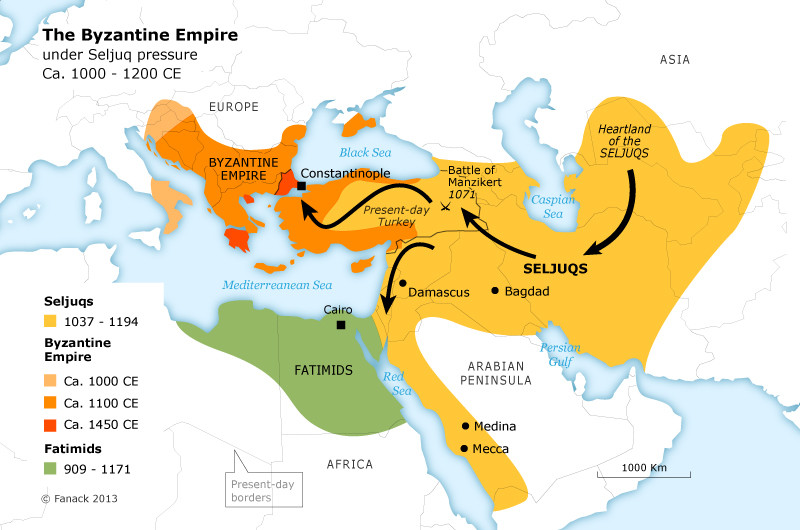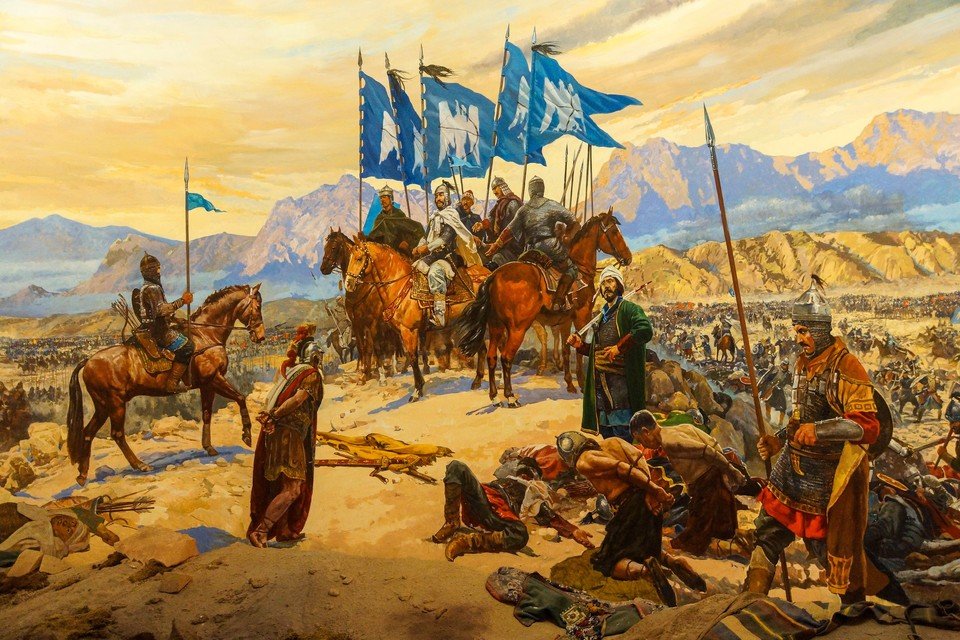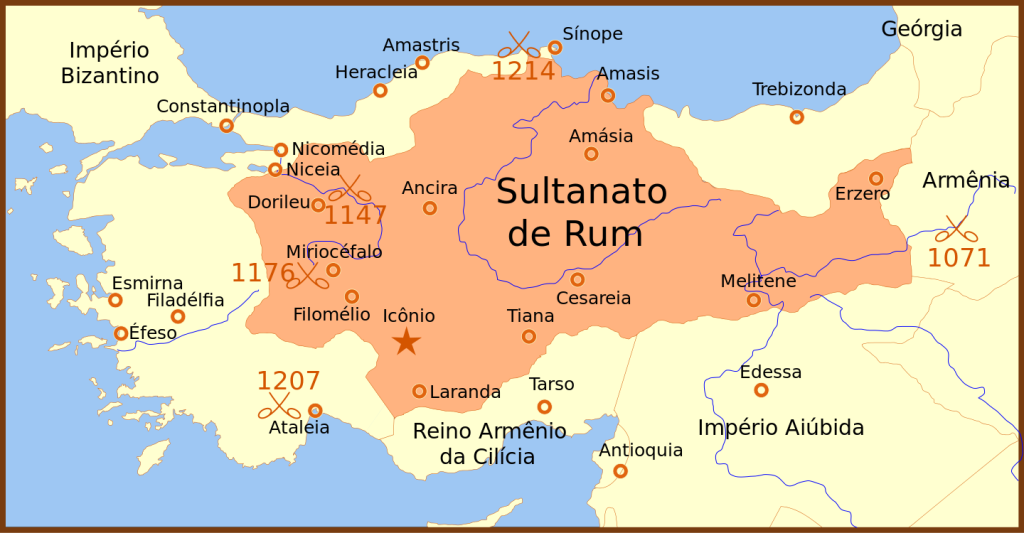Turkish tribes marched from Central Asia to the West in the 11th century. The Turks, who settled in Isfahan in Iran, established a state that would later be known as the Great Seljuk Empire.
In the region where the Seljuk Turks settled, there were Christians and Jews as well as Muslims. As the Seljuk Empire expanded, a cosmopolitan structure emerged in its lands.
The Seljuks pursued a tolerant policy that made it possible for all cultures to live together. Thus, it was ensured that the trade routes between Asia and Europe continued to function.
Seljuk Empire Map, History and Facts
Known as Seljuk Empire, this state was declared the protector of Islam by Abbasid Caliph who was living in Baghdad and it ruled over the holy lands. As the ancestors of the western Turks, they blended the cultures and created the hybrid ethos that you can still observe in modern Turkey. When you examine the Seljuk Empire map below, you can see how strategically the state has spread.
1. March of the Turks to the West
The Abbasid Caliph in Baghdat, granted Seljuk’s leader Tuğrul (Tughril), the impressive title of “King of the East and West” designating the Seljuk warlord as his temporal deputy.
Alp Arslan (Successor) expanded significantly upon Tughril’s holdings by adding Armenia and Georgia (1064). He had captured eastern fringes of the Byzantine Empire (1068). Then the war between Seljuks and Byzantines was inevitable.
The map depicts the march of Seljuk Turks from Central Asia to the Eastern borders of Byzantine Empire. You can see where the Battle of Manzikert took place marked on the map. That battle opened the gates of Anatolia (Asia Minor) to the Turks.
2. Seljuk Empire and Battle of Manzikert
In 1071, the armies of the Seljuk Sultan and the Byzantine Emperor confronted in Manzikert, north of Lake Van. Although Romanos IV Diogenes was a respected soldier, he was someone disliked by the nobility of the capital. He could not get along well with officers from the noble dynasties in the army.
Many negative events took place until Romanos arrived at the battlefield. For this reason, the morale of the Byzantine army was low. He had also divided his army in two because he could not predict where the war would take place. This mistake would result in a disaster.
Even the remaining half of Romanos’ army was larger than the army of the Alp Arslan. However, it did not form a unity because there were many high-ranking officers who did not like Romanos.
While the two armies continued the war, the Seljuks applied a tactic from the Turkish-Mongolian tradition. As the center of the Seljuk army suddenly retreated, the Byzantines began to chase them. This move, one of the most common tactics of Asian steppes, caused the Byzantines to be trapped.
The Seljuk army, which opened to the wings, pressed the Byzantine army from the sides. Effective Selcuk cavalry, who had been hiding behind the hills until then, also attacked.
The Byzantine army hesitated for a moment. In fact, if there was a strong cohesion in the army, they had the strength to recover and resist. However, they failed to retreat at the right time. The emperor’s orders did not reach the right wing, and the withdrawal maneuver did not work.
The pincer movement gave the result that the Seljuks had expected. The Byzantine army, which could not survive the shock, could not reorganize. The right wing of Byzantines was completely routed. General Andonikos Doukas, whom Romanos positioned as the rearguard, clearly betrayed and did not fight.
The central army, including Romanos, was surrounded and destroyed by the Seljuk army. The emperor was also captured. In fact, the Seljuks did not treat Romanos badly. They signed a peace treaty and released him.
Of course they had all the concessions they could get from the emperor, but they wanted Romanos to be on the throne. However, the Doukas Dynasty, of which General Andronikos was a member, had taken over the throne. This was the reason of betrayal from the very beginning.
Romanos struggled to take back the throne but failed. He was caught and imprisoned in a monastery near Constantinople. However, due to the civil war between the Romanos and the Doukas, Byzantine military power was much reduced.
3. The Rise and Fall of the Seljuk Empire
The fact that Sultan Alp Arslan won the Battle of Manzikert cracked the Byzantine defense completely. Before Byzantines found time to get on their feet, Seljuks had already captured Eastern and Central Anatolia.
The reigns of Alp Arslan and his successor Malik Shah, were the prosperous years of the Seljuk Empire. There was a strong central government, ruled by the emperor and his wise man council. Emperor had to take the advice of the elderly people in the council. This was a tradition that had existed from the times of the ancient Turks in Central Asia.
The state economy was strong due to the strategic position of Seljuk Empire. They were dominating the keypoints on the major trade routes of the World: Silk Road and Spice Route. They became more powerful with this great income.
The death of the Malik Shah marked the decline of Great Seljuks and by 1192 the dynasty ended. The pressures from the Crusaders and new Turcoman clans caused the Great Seljuk Empire to collapse.
4. Sultanate of Rum
The remaining Seljuk clans established their new capital at Iconium (Konya) around 1150 and ruled what would be known as the Seljuk Sultanate of Rum. Rum means Roman in Turkish lenguage. So literally the name of the state was Seljuks of Rome which was also meaning Seljuks of the West.
The Byzantine Empire was defined as Roman Empire in the middle ages, “Byzantine” term made up by the historians in the modern times. Seljuks used this name as they considered themselves the new rulers of the Roman territories. Centuries later, Mehmed II, the Ottoman Sultan who conquered the Constantinople, used the title of “Roman Emperor” besides his other titles such as Khan, Sultan and Shah.
The small Seljuk ruling class governed a population that was mostly Greek-speaking Anatolian Christians, as well as a significant Jewish minority. Seljuks showed a tolerant administration for the continuation of traditional trade and for everyone to live in peace.
The Seljuk rule was tolerant of race and religion. Churches and synagogues flourished, most of the finest examples of Seljuk architecture, such as the fine caravanserais and the mosques, medreses were built at Anatolia. Some of the best examples of these can be seen in Erzurum (Theodosiopolis), Sivas (Caesarea) and Konya (Iconium) even today.
5. The Rise of a Philosopher: Rumi
The city of Konya, which was the heart of Seljuk Sultanate of Rum, saw the results of the freedom of faith and philosophy of the era. One of the biggest poets, thinkers and scholars of the history of Islam, Rumi, lived in Konya and developed Sufism. With his spiritual leadership and oration, he gathered whirling dervishes around him.
6. Founding of the Ottoman Empire
The red city-state in the map was the Ottoman Turks. They grew into Ottoman Empire from a little vassal state. The green state on Europe is what is left from the Byzantine Empire in 14th Century. Map describes how Byzantine Empire shranked into a little state in centuries.
The Seljuks had come from the East two centuries ago and occupied the Byzantine lands. A strange turn of fate brought them to the same outcome. Worn off as a result of the pressure by the tribes coming from the East, Seljuks could not resist the strong attacks of the Mongols and they were decisively defeated at the Battle of Kose Dag.
After the fall of Seljuk Empire, many Turkish principalities appeared. Among those, there was one principality that came on top of others with its dynamism and belligerence. Ottoman Principality and its founder Osman (Othman) paved the way for the foundations of one of the biggest empires ever in the history of humankind.
Written by Serhat Engul




Leave a Reply